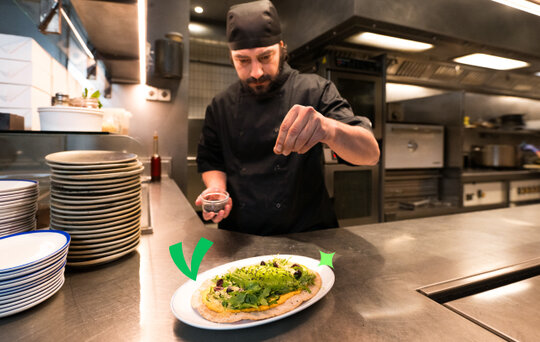From purchase to table: strategies for restaurant inventory management

- • The importance of restaurant inventory management
- • Choosing the right restaurant inventory management software
- • Try TheFork Manager today
- • Implementing an effective restaurant inventory management system
- • Further tips for inventory management in the restaurant industry
- • Empty tables and ever-increasing costs?
For any restaurant, inventory management is a key operation in need of careful control. Not only is it crucial for restaurant profitability, as it ensures that food supplies are carefully tracked to prevent shortages, but effective inventory control can also be key to helping manage the various competing pressures upon restaurants, including costs, quality control, and customer satisfaction. Luckily, managing inventory levels as a restaurant owner is now easier than ever, thanks to restaurant stock management software that can help streamline operations.
The importance of restaurant inventory management
All restaurants have food stock, but it must be properly managed to avoid waste and increase profitability. There are many reasons why it is essential for restaurateurs to effectively manage food inventory:
- Reduce Food Costs: To take control of your menu’s profitability, make managerial decisions that help your bottom line. Although fresh ingredients are important for customer satisfaction and retention, ask yourself if resources are being used to their full advantage and make savings wherever possible.
- Optimise Stock Control: With rotating menu items requiring different ingredients and quantities, keeping track of restaurant supplies can be a constant battle. Use forecasting tools to predict demand to avoid stockouts on essential ingredients.
- Improve Productivity: Kitchen staff often spend considerable time keeping track of sitting inventory. Finding ways to streamline processes can give staff more time to cook by improving operational efficiency and reducing time spent on stock checks.
- Enforce Quality Control: Ensure the quality and freshness of ingredients by implementing rigorous systems that automatically rotate stock to ensure less goes to waste before it is even used.
- Minimise Waste: By carefully tracking what is wasted, restaurants can avoid overconsumption of expensive goods and improve portion control. Taking steps to reduce food waste is both profitable and sustainable.
Choosing the right restaurant inventory management software
Finding the ideal restaurant inventory management software for your establishment is a crucial decision based on various factors. Begin by considering the restaurant’s needs based on its size, ethos, service style and location. When choosing software, look to align its purpose with specific uses within your establishment. For smaller restaurants, simpler tools like stock trackers may be up to the job, whereas multi-location chains may need to seek out more robust tools.
With this in mind, next, ask what the software needs to be able to do to streamline operations and improve efficiency. Some of the features and functionalities to look out for include:
- Automated Stock Tracking: Periodic Automatic Replacement, or PAR level, is an automatic stockroom management system that monitors inventory levels and determines optimum amounts after each order delivery.
- Low-Stock Alerts: When inventory count gets too low, the ability to receive warning notifications can help prevent stockouts.
- Inventory Reporting: Comprehensive reporting with data-driven insights that track usage and wastage can help drive informed purchasing decisions and feedback on the overall Cost of Goods Sold (COGS).
- POS-Integration: Restaurant inventory management software that seamlessly connects to your POS system can allow real-time tracking of stock based on sales, reducing manual input errors. What’s more, it provides an easy interface for managers to get instant insight into more aspects of the business.
Having developed our own industry-leading platform, TheFork Manager, to help restaurateurs efficiently manage their businesses, we know just how important restaurant inventory management can be. That’s why we’ve developed a number of specialised features and widgets to help efficiently handle stock levels, avoid unnecessary waste, and streamline operations.
Try TheFork Manager today
Implementing an effective restaurant inventory management system
Having selected an inventory management software that works for you and your business, it is important to follow best practices when implementing new systems:
- Train Staff: Ensure staff understand how to use all new software effectively. For example, TheFork Manager team provides experts and consultants to train staff and assist with any technical issues while using the platform. With hands-on support for you and your staff, expect to benefit from staff being able to use their new software with confidence.
- Streamline Inventory Procedures: To allow your new software to shine, set up clear processes for receiving and storing inventory to avoid human error when entering data into the system. Clear guidelines on the ground help store fresh products safely for longer.
- Don’t Remove Physical Checks: Even with software to do the heavy lifting, regular physical inventories are still crucial to verify data accuracy and stop any discrepancies between real and recorded inventory counts.
- Use the Software Well: Use your new system to the best of its ability! Actively monitor inventory levels and heed automated notifications to keep on top of stock and ensure replenishment on time. Then, use reports and analytics to identify trends and areas for improvement.
Further tips for inventory management in the restaurant industry
Assisted by your new technology, your restaurant’s operational efficiency is sure to skyrocket. In addition, here are some small practical strategies to improve inventory management alongside software programmes:
- Adopt a ‘First In, First Out’ (FIFO) Culture: Excellent stock rotation is essential to maintaining fresh inventory and preventing wastage.
- Label: Implementing an effective labelling system can save time and add clarity, easily helping staff to identify expiration dates.
- Conduct Audits: Periodically audit your inventory to avoid discrepancies between online and physical systems.
- Automate Processes: To streamline operations further and save time for staff, leverage automated technologies like barcode scanners and digital scales.
- Seek Advice from Industry Experts: Consult with professionals like TheFork Manager team, who can offer tailored advice and guidance to improve individual establishments.
When combined with an appropriate and well-integrated software solution, these strategies will help your restaurant to shine, boosting profitability, reducing waste, and saving your staff valuable time.
Running a successful restaurant requires managers to effectively optimise operations in all of these areas: discover TheFork Manager and get started!
Empty tables and ever-increasing costs?
- The importance of restaurant inventory management
- Choosing the right restaurant inventory management software
- Try TheFork Manager today
- Implementing an effective restaurant inventory management system
- Further tips for inventory management in the restaurant industry
- Empty tables and ever-increasing costs?















